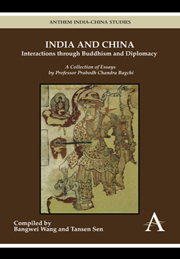 India and China: Interactions through Buddhism and Diplomacy
India and China: Interactions through Buddhism and Diplomacy Influence of Indian Music in the Far East
from Part Three - Articles in Bengali
Published online by Cambridge University Press: 05 March 2012
Summary
The rich Indian culture spread to various cultural spheres of the Far East. Indian philosophy, literature, science and art left their distinct marks through Buddhism. Over the ages the profound impact of the multifaceted Indian culture enriched these countries by enkindling their creativity in various spheres of culture. However, the influence of Indian music remains hidden behind the history of the music of these countries.
Many civilised nations and races inhabiting Central Asia adopted Indian music and, due to cultural contacts, the prevalent music of Central Asia was incorporated into Indian treatises on music. From the various references to Indian ragas (principal modes of Indian classical music) in our treatise on music, there are indications of this unique absorption of foreign music. Todi and Khambaj, two North Indian ragas and principal modes of Indian classical music, could have some connection with Turkey and Kamboj (i.e., ancient Iran) as the names of these ragas suggest. In the fifth and sixth centuries of the Christian Era, the Turkish people infiltrated into India. Similarly, an ethnic group of people from Central Asia called Kamboj also migrated to India and settled permanently on the northwestern frontiers of the country. It is quite likely that the infiltration of these foreigners had impact on the cultural life of people and music occupies an integral part of culture.
- Type
- Chapter
- Information
- India and China: Interactions through Buddhism and DiplomacyA Collection of Essays by Professor Prabodh Chandra Bagchi, pp. 209 - 212Publisher: Anthem PressPrint publication year: 2011


